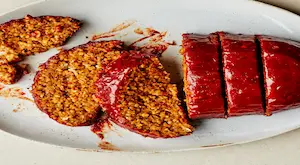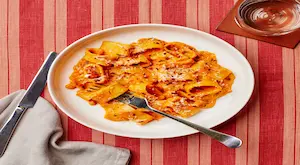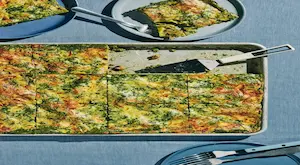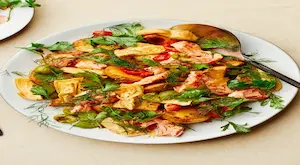
Introduction:
In the realm of comfort food, few dishes hold the nostalgic charm of a perfectly baked meatloaf. Traditionally associated with hearty family dinners, the quintessential meatloaf has undergone a remarkable evolution to accommodate the growing demand for plant-based alternatives. Vegan meatloaf, with its cruelty-free and environmentally conscious appeal, has become a star in the world of plant-based cuisine. In this comprehensive guide, we will explore the art and science of crafting the perfect vegan meatloaf, from choosing the right protein base to infusing layers of flavor and creating a mouthwatering glaze.
The Foundation: Choosing the Right Protein Base
The heart of any meatloaf lies in its protein content, and for vegan meatloaf, the possibilities are vast. Plant-based proteins like lentils, black beans, chickpeas, tempeh, and textured vegetable protein (TVP) are just a few options that can mimic the texture and satisfying bite of traditional meatloaf. Each protein source brings its own unique qualities to the table, allowing for a diverse range of flavors and textures.
- Lentil and Walnut Vegan Meatloaf:
- Ingredients:
- Cooked green or brown lentils
- Chopped walnuts
- Onion, garlic, and celery
- Breadcrumbs
- Flaxseed egg (ground flaxseed mixed with water)
- Method:
- Sauté onions, garlic, and celery until softened.
- Combine cooked lentils, chopped walnuts, sautéed vegetables, breadcrumbs, and flaxseed egg.
- Season with herbs and spices of choice.
- Form into a loaf shape and bake until golden.
- Ingredients:
- Chickpea and Mushroom Vegan Meatloaf:
- Ingredients:
- Chickpeas
- Chopped mushrooms
- Oats or breadcrumbs
- Tomato paste
- Soy sauce
- Method:
- Pulse chickpeas and mushrooms in a food processor.
- Mix with oats or breadcrumbs, tomato paste, and soy sauce.
- Shape into a loaf and bake until firm and golden.
- Ingredients:
- Quinoa and Black Bean Vegan Meatloaf:
- Ingredients:
- Cooked quinoa
- Black beans
- Corn
- Smoked paprika and cumin
- Vegan barbecue sauce
- Method:
- Mash black beans and mix with cooked quinoa, corn, and spices.
- Form into a loaf, brush with barbecue sauce, and bake to perfection.
- Ingredients:
The Binding Agent: Holding it All Together
Traditional meatloaf relies on eggs to bind the ingredients together. In the world of vegan cooking, there are several effective substitutes to achieve that perfect consistency. Flaxseed or chia seed eggs, mashed potatoes, sweet potatoes, or silken tofu can all serve as excellent binding agents. Not only do these alternatives hold the loaf together, but they also contribute to the overall moisture and richness of the dish.
- Flaxseed or Chia Seed Egg:
- Mix one tablespoon of ground flaxseeds or chia seeds with three tablespoons of water.
- Let it sit for a few minutes until it forms a gel-like consistency.
- Use as a replacement for each egg in the recipe.
- Mashed Potatoes or Sweet Potatoes:
- Boil or steam potatoes until tender.
- Mash and incorporate into the loaf mixture for a creamy texture.
- Silken Tofu:
- Blend silken tofu until smooth.
- Use as a creamy binding agent for a moist and rich meatloaf.
Adding Flavor and Depth: A Symphony of Herbs and Spices
Vegan meatloaf offers a canvas for culinary creativity, allowing you to infuse layers of flavor with herbs and spices. Traditional favorites like garlic, onion powder, thyme, and rosemary can be complemented by smoked paprika, cumin, nutritional yeast, and even a touch of liquid smoke for that unmistakable umami essence.
Experiment with different combinations to find the flavor profile that suits your taste buds. Consider adding finely chopped onions, garlic, bell peppers, or grated carrots to introduce additional depth and texture to your vegan meatloaf.
- Savory Herb Blend:
- Combine dried thyme, rosemary, oregano, and sage for a classic savory flavor.
- Add a hint of garlic powder and onion powder for depth.
- Umami Boosters:
- Incorporate ingredients like soy sauce, tamari, or liquid aminos for a savory and salty kick.
- Smoked paprika and cumin can add a smoky and earthy undertone.
- Cheesy Infusion:
- Nutritional yeast is a vegan kitchen staple that imparts a cheesy flavor to your meatloaf.
- Experiment with vegan cheese shreds for an extra layer of richness.
The Glaze: Sealing in Moisture and Flavor
No meatloaf – vegan or otherwise – is complete without a tantalizing glaze. Traditional meatloaf often features a ketchup-based glaze, and vegan alternatives can be just as, if not more, delicious. A combination of tomato paste, maple syrup, balsamic vinegar, and Dijon mustard creates a sweet and tangy glaze that enhances both the visual appeal and flavor of your vegan meatloaf.
- Classic Tomato-Based Glaze:
- Mix tomato paste, maple syrup, balsamic vinegar, Dijon mustard, and a pinch of salt.
- Brush the glaze over the loaf before baking and again halfway through.
- Barbecue-Style Glaze:
- Combine vegan barbecue sauce with a touch of soy sauce or tamari for depth.
- Brush over the loaf for a smoky and sweet finish.
- Sweet and Tangy Mustard Glaze:
- Mix Dijon mustard, agave or maple syrup, and apple cider vinegar.
- Brush over the loaf for a zesty and flavorful crust.
Toppings and Add-Ins: Elevating the Experience
To take your vegan meatloaf to the next level, consider adding toppings or incorporating additional ingredients into the loaf mixture. Sliced vegetables or mushrooms can create an appealing visual layer on top of your loaf, while ingredients like sun-dried tomatoes, olives, or even vegan sausage can add bursts of flavor.
- Vegetable Toppings:
- Arrange sliced tomatoes, bell peppers, or mushrooms on top of the loaf before baking.
- Drizzle with olive oil and sprinkle with herbs for a vibrant finish.
- Nutty Crunch:
- Incorporate chopped nuts, such as walnuts or pecans, into the loaf mixture for a delightful crunch.
- Sprinkle additional nuts on top for added texture.
- Sun-Dried Tomato and Olive Infusion:
- Fold in chopped sun-dried tomatoes and olives for a burst of Mediterranean flavor.
- Top with extra tomatoes and olives for a visually appealing presentation.
Baking Techniques: Perfecting the Texture
Achieving the ideal texture in your vegan meatloaf involves a combination of the right ingredients and proper baking techniques. Here are some tips to ensure your meatloaf comes out moist, flavorful, and perfectly cooked:
- Preheat Your Oven:
- Ensure your oven is fully preheated before placing the meatloaf inside. This helps set the shape and texture from the beginning.
- Covering vs. Uncovering:
- Covering the meatloaf with foil during the first part of baking helps retain moisture.
- Uncover for the last part of baking to allow the glaze to caramelize and create a flavorful crust.
- Internal Temperature:
- Use a meat thermometer to check the internal temperature of your meatloaf. It should reach around 160°F (71°C) for optimal doneness.
- Resting Time:
- Allow the meatloaf to rest for a few minutes after baking. This helps the juices redistribute, ensuring a moist and flavorful outcome.
Vegan Meatloaf Recipes to Try:
- Hearty Lentil and Walnut Vegan Meatloaf:
- Ingredients:
- 2 cups cooked green or brown lentils
- 1 cup chopped walnuts
- 1 onion, finely chopped
- 3 cloves garlic, minced
- 1 celery stalk, finely chopped
- 1 cup breadcrumbs
- 1 flaxseed egg (1 tablespoon ground flaxseed mixed with 3 tablespoons water)
- 1 teaspoon thyme, dried
- 1 teaspoon rosemary, dried
- Salt and pepper to taste
- Tomato-based glaze (mix of tomato paste, maple syrup, balsamic vinegar, Dijon mustard)
- Method:
- Sauté onions, garlic, and celery until softened.
- In a large bowl, combine cooked lentils, chopped walnuts, sautéed vegetables, breadcrumbs, flaxseed egg, thyme, rosemary, salt, and pepper.
- Mix until well combined and the mixture holds together.
- Shape into a loaf and place in a baking dish.
- Brush the tomato-based glaze over the loaf.
- Bake in a preheated oven at 375°F (190°C) for 40-45 minutes or until golden brown.
- Allow the meatloaf to rest for a few minutes before slicing and serving.
- Ingredients:
- Savory Chickpea and Mushroom Vegan Meatloaf:
- Ingredients:
- 2 cans chickpeas, drained and rinsed
- 2 cups chopped mushrooms
- 1 cup oats or breadcrumbs
- 2 tablespoons tomato paste
- 1 tablespoon soy sauce
- 1 teaspoon thyme, dried
- 1 teaspoon smoked paprika
- Salt and pepper to taste
- Barbecue-style glaze (vegan barbecue sauce and soy sauce)
- Method:
- In a food processor, pulse chickpeas and mushrooms until combined but still slightly chunky.
- Transfer the mixture to a bowl and add oats or breadcrumbs, tomato paste, soy sauce, thyme, smoked paprika, salt, and pepper.
- Mix until well combined and the mixture holds together.
- Shape into a loaf and place in a baking dish.
- Brush the barbecue-style glaze over the loaf.
- Bake in a preheated oven at 375°F (190°C) for 40-45 minutes or until firm.
- Allow the meatloaf to rest before slicing and serving.
- Ingredients:
- Quinoa and Black Bean Vegan Meatloaf with Smoky Barbecue Glaze:
- Ingredients:
- 2 cups cooked quinoa
- 1 can black beans, drained and mashed
- 1 cup corn
- 1 teaspoon smoked paprika
- 1 teaspoon cumin
- Salt and pepper to taste
- Vegan barbecue sauce
- Method:
- In a bowl, combine cooked quinoa, mashed black beans, corn, smoked paprika, cumin, salt, and pepper.
- Mix until well combined and the mixture holds together.
- Shape into a loaf and place in a baking dish.
- Brush a generous amount of vegan barbecue sauce over the loaf.
- Bake in a preheated oven at 375°F (190°C) for 40-45 minutes or until the top is caramelized.
- Allow the meatloaf to rest before slicing and serving.
- Ingredients:
Conclusion:
The journey to creating the perfect vegan meatloaf is a delightful exploration of flavors, textures, and plant-based ingenuity. As the popularity of plant-based diets continues to rise, the culinary world is witnessing an exciting evolution of traditional dishes into compassionate and sustainable alternatives. Whether you’re a seasoned vegan chef or a curious newcomer to plant-based cooking, crafting a delectable vegan meatloaf is not only a testament to your culinary skills but also a celebration of the endless possibilities that the world of vegan cuisine has to offer. So, roll up your sleeves, gather your ingredients, and embark on a culinary adventure that promises a symphony of flavors in every bite.



